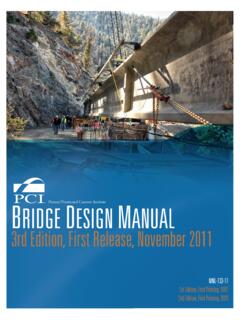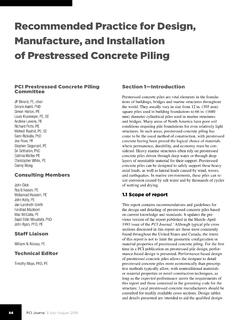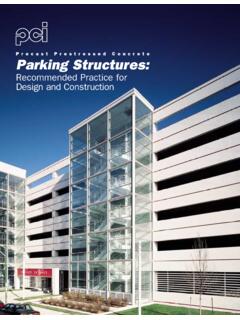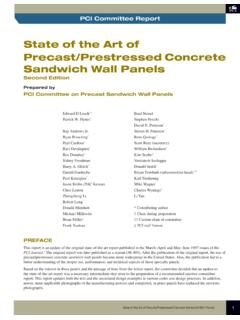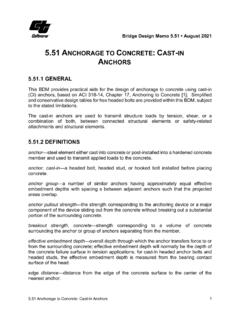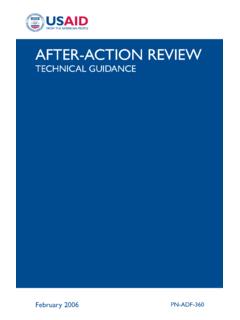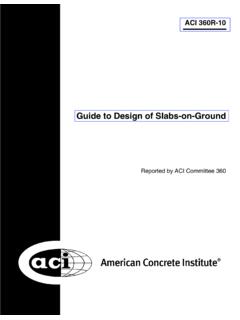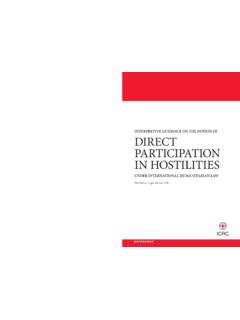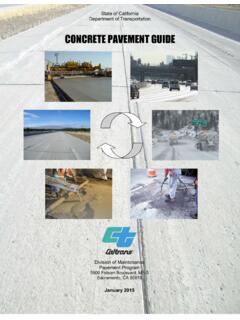Transcription of Flexural Strength of Reinforced and Prestressed Concrete T ...
1 Flexural Strength of Reinforced and Prestressed Concrete T-Beams Stephen J. Seguirant, The calculation of the exural Strength of Concrete Vice President and Director of Engineering T-beams has been extensively discussed in recent Concrete Technology Corporation issues of the PCI JOURNAL. The debate centers Tacoma, Washington on when T-beam behavior is assumed to begin. The AASHTO LRFD Bridge Design Speci cations (LRFD) maintain that it begins when c (distance from extreme compression ber to neutral axis). exceeds the thickness of the ange. The AASHTO. Standard Speci cations for Highway Bridges (STD), and other references, contend that it begins when Richard Brice, a (depth of equivalent rectangular stress block) ex- Bridge Software Engineer Bridge & Structures Of ce ceeds the ange thickness.
2 This paper examines the Washington State Department of fundamentals of T-beam behavior at nominal ex- Transportation ural Strength , and compares the results of LRFD. Olympia, Washington and STD with more rigorous analyses, including the PCI Bridge Design Manual (PCI BDM) method and a strain compatibility approach using nonlinear Concrete compressive stress distributions. For pre- tensioned T-beams of uniform Strength , a method consisting of a mixture of LRFD and STD is investi- Bijan Khaleghi, , Concrete Specialist gated. For T-beams with different Concrete strengths Bridge & Structures Of ce in the ange and web, the PCI BDM method is com- Washington State Department of pared with the nonlinear strain compatibility analy- Transportation sis. High Strength concretes (HSC) up to 15,000 psi Olympia, Washington (103 MPa) are considered.
3 The selection of appro- priate factors and maximum reinforcement limits is also discussed. Comparisons with previous tests of T-beams are presented, and revisions to the rel- evant sections of LRFD are proposed. 44 PCI JOURNAL. T. he proper calculation of the exural Strength of T-beams in the ange. Since the LRFD and STD methods are not has been the subject of much discussion in recent is- adaptable to this analysis, only the PCI BDM and nonlinear sues of the PCI There is a distinct differ- strain compatibility methods will be compared. This com- ence in the calculated capacities of Reinforced and Prestressed parison is used to evaluate the average 1 approach of the Concrete T-beams determined by the AASHTO LRFD Bridge PCI BDM method. Design Speci cations (LRFD),4 and the methods given in The increase in the calculated depth to the neutral axis re- other codes and references,5-7 including the AASHTO Stan- sulting from LRFD impacts the design of T-beams in other dard Speci cations for Highway Bridges (STD).
4 8 The differ- ways than simply reducing the design exural Strength . Since ence lies primarily in the treatment of the ange overhangs at LRFD limits the effectiveness of the tension reinforcement to nominal exural Strength . beams with c/de ratios less than or equal to , an increase References 5 through 8 claim that T-beam behavior begins in c will lead to beams with reduced maximum reinforcement when the depth of the equivalent rectangular compressive ratios. Thus, beams become over- Reinforced more quickly stress block, a, exceeds the thickness of the ange, hf . Thus, using LRFD than other codes and references. the entire ange overhang area is allowed to carry a compres- For under- Reinforced members, the resistance factor is sive stress of intensity '. taken as for non- Prestressed exural members and On the other hand, LRFD requires that a section be treated for precast, Prestressed exural members in both LRFD and as a T-beam once the depth to the neutral axis, c, becomes STD.
5 Neither speci cation allows over- Reinforced non-pre- greater than the thickness of the ange. The depth of the stressed exural members. However, both speci cations equivalent rectangular compressive stress block in the ange allow over- Reinforced Prestressed exural members, but no overhangs is limited to a = 1hf , where the value of 1 is be- credit is given for reinforcement in excess of that which tween and , depending on the Strength of the con- would result in an under- Reinforced section. crete in the ange. Thus, the ange overhang area that is ef- LRFD allows over- Reinforced Prestressed and partially fective in resisting compression is reduced by between 15 and Prestressed members if it is shown by analysis and experi- 35 percent when compared to other codes and references. mentation that suf cient ductility of the structure can be To ensure that equilibrium is maintained with the tension achieved.
6 No guidance is given for what suf cient ductil- force in the steel, the loss of effective compressive area in the ity should be, and it is not clear in either speci cation what ange overhangs must be replaced by additional compressive value of should be used for such over- Reinforced members, area in the web. This results in a signi cant increase in the though some designers have used = Maximum rein- calculated depth to the neutral axis. The internal moment arm forcement limits and appropriate resistance factors will both between the compression and tension forces is reduced, as is be discussed with respect to Prestressed and non- Prestressed the calculated moment capacity. exural members. This paper examines the behavior of T-beams at nominal To validate the analysis procedures, available test data exural Strength .
7 The fundamental theory is explained, and are evaluated and compared with the results of the various equations are derived for the various calculation methods calculation methods. Recommended revisions to LRFD are used in the study. Explanations are provided for the differ- also presented. ences between the various methods, with special emphasis on the difference between the LRFD method and the methods of other codes and references. THEORETICAL CONSIDERATIONS. Parametric studies are used to compare the results of the Assumptions various calculation methods. For non- Prestressed T-beams, the LRFD and STD methods are compared with the results of The following assumptions are adapted from Reference 10, a strain compatibility analysis using nonlinear Concrete com- and are common to all of the calculation methods used in this pressive stress-strain curves.
8 The nonlinear analysis removes study, except as noted: 1 as a variable, and allows for a fair comparison between the 1. The Strength design of exural members is based on three calculation methods. Concrete strengths ranging from satisfaction of applicable conditions of equilibrium 7000 to 15,000 psi ( to 103 MPa) are investigated. and compatibility of strains. Prestressed beams are also evaluated. In one study, the 2. Strain in bonded reinforcement and Concrete is exural Strength of pretensioned T-beams with a Concrete assumed to be directly proportional to the distance Strength of 7000 psi ( MPa) in both the ange and web from the neutral axis. are compared using ve different analyses: LRFD, STD, 3. The maximum usable strain at the extreme Concrete the PCI Bridge Design Manual9 (PCI BDM) strain com- compression ber is assumed to be patibility method, a nonlinear strain compatibility analysis, 4.
9 For non- Prestressed reinforcement, stress in the and an analysis mixing the LRFD and STD methods. In this reinforcement below the speci ed yield Strength fy case, the width of the ange is varied between 48 and 75 in. for the grade of reinforcement used is taken as Es (1220 to 1905 mm) in 9 in. (229 mm) increments to deter- times the steel strain. For strains greater than that mine the effect of ange width on the calculations. corresponding to fy , stress in the reinforcement is Another study examines pretensioned beams with con- considered independent of strain and is equal to fy . For crete strengths ranging from 7000 to 15,000 psi ( to 103 prestressing steel, fps is substituted for fy in Strength MPa) in the web and 4000 to 8000 psi ( to MPa) computations. January-February 2005 45.
10 Derivation of Equations for 5. The tensile Strength of Concrete is neglected in all the Flexural Strength of T-Beams exural Strength calculations. Although the parametric studies do not include mild steel 6. The relationship between the Concrete compressive compression reinforcement, and the studies of Prestressed stress distribution and Concrete strain is assumed to be Concrete members do not include mild steel tension rein- rectangular for all calculation methods of this paper forcement, the following derivations for LRFD and STD in- except the nonlinear analysis. For this analysis, the clude both for the sake of completeness. Note that whenever nonlinear Concrete stress-strain relationship is taken mild steel compression reinforcement is considered in the from Collins and calculations, the stress should be checked to ensure that the 7.


